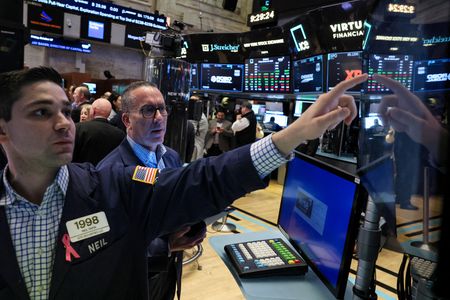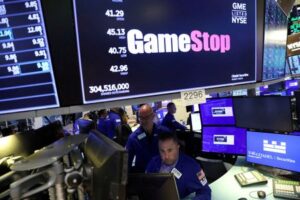By Herbert Lash and Alun John
NEW YORK/LONDON (Reuters) – A gauge of global equities rose and Treasury yields rebounded on Monday after last week’s big rally in stocks and bonds on hopes that interest rates will soon be cut faded, with markets assessing an improving but still uncertain outlook for growth and inflation.
The three main stock indices on Wall Street eked out gains, while major European equity indices closed down. The yield on 10-year Treasuries rose 9.1 basis points (bps) to 4.649%, reversing some of the 29 bps decline last week when the benchmark note posted its biggest weekly drop since March.
A benign U.S. payrolls report on Friday and upbeat productivity numbers suggested the American labor market was cooling enough for the Federal Reserve to halt the need for further rate increases.
But the drop in market yields is a double-edged sword as they could increase corporate loans and spur economic growth, said Gennadiy Goldberg, head of U.S. rates strategy at TD Securities in New York.
“The markets are in wait-and-see mode,” Goldberg added, as traders assess whether the economy slows further or in fact proves to be more resilient than the Fed would like to see.
The U.S. central bank could even be forced to raise rates to ensure the pace of inflation remains on a downward trajectory and does not bounce back, Goldberg said.
Futures now see the Fed’s overnight lending rate staying above 5% through next June instead of July, and have priced in almost 85 bps of rate cuts by the end of 2024, or more than the 50 bps of cuts envisioned recently by policymakers.
MSCI’s gauge of stocks across the globe closed up 0.4% to post its sixth consecutive session of gains. But the pan-European STOXX 600 index lost 0.16% as the major stock indices for France, Germany, Italy and Spain all fell.
On Wall Street, the Dow Jones Industrial Average rose 0.1%, the S&P 500 gained 0.18% and the Nasdaq Composite added 0.3%.
‘SOME EQUILIBRIUM’
“You need to see some equilibrium and some stabilization in rates to give more confidence that we have plateaued in terms of market rates,” said Anthony Saglimbene, chief market strategist at Ameriprise Financial in Troy, Michigan.
Stabilization can provide a little bit of bounce for equities and a little bit of price appreciation for the bond market, Saglimbene added.
“Then investors can start pricing for what’s the cost of capital as a business, what’s the outlook for refinancing that debt?” Saglimbene said. “We’re just not there yet.”
Markets also imply about an 80% probability that the European Central Bank (ECB) will cut rates by April, while the Bank of England (BoE) is seen easing in August.
Central bankers have their own chance to weigh in on this dovish outlook, with at least nine Fed members speaking this week, including Chair Jerome Powell. Also on the docket are speakers from the BoE and ECB.
An outlier is Australia’s central bank, which is considered likely to resume raising rates at a policy meeting on Tuesday as inflation there stays stubbornly high.
The Bank of Japan is also on the road to tightening, albeit at a glacial pace. The head of the central bank said on Monday it was closer to achieving its inflation target, but it was still not enough to end ultra-loose policy.
Hopes for lower borrowing costs overnight helped shares in Asia, which missed out on Friday’s rally that was inspired by the U.S. jobs data.
MSCI’s broadest index of Asia-Pacific shares outside Japan gained 2.1% on Monday.
South Korea stood out, climbing 5.66% as authorities re-imposed a ban on short-selling to mid-2024.
Germany’s bund yield, the euro zone benchmark, rose 0.8 bps to 2.746% after seven sessions of declines.
The recent retreat in Treasury yields stymied the dollar last week. The dollar index, a measure of the U.S. currency against six others, rose 0.12% at 105.19 after sliding 1.4% last week.
The euro slipped 0.05% to $1.0723 after earlier hitting an eight-week high of 1.0756 following 1% surge on Friday. The dollar has lost ground in recent sessions even to the ailing yen to stand at 149.975 yen, a bit off from its recent top of 151.74. [FRX/]
The drop in the dollar and yields has helped underpin gold, as investors have cautiously turned back to riskier assets. U.S. gold futures settled 0.5% lower at $1,988.60 an ounce.
Oil prices edged higher after top exporters Saudi Arabia and Russia reaffirmed their commitment to extra voluntary oil supply cuts until the end of the year.
Brent crude futures settled 29 cents higher at $85.18 a barrel, while U.S. West Texas Intermediate crude settled up 31 cents at $80.82.
(Reporting by Herbert Lash, additional reporting by Wayne Cole and Alun John; Editing by Nick Macfie, Will Dunham, Mark Potter and Marguerita Choy)





